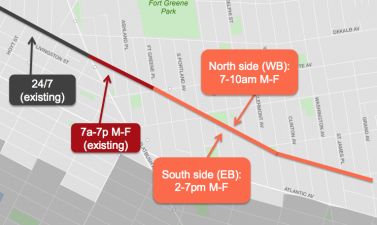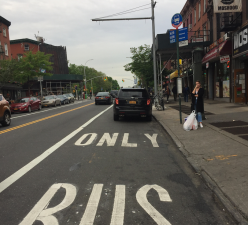James and Cumbo Wilt Under Pressure, Oppose Clinton Ave Bikeway

Last year, Public Advocate Tish James called on DOT to make protected bike lanes a standard feature of street redesigns, a stance she recently elaborated on in an interview with Streetsblog. In December, Council Member Laurie Cumbo stood with the family of Victoria Nicodemus, who was run over and killed on a Fort Greene sidewalk, at a vigil for safer streets.
Now DOT is making a concrete proposal to redesign a street in Cumbo’s district for greater safety [PDF] — a plan for a two-way protected bike lane on Clinton Avenue first floated at the “Vision Zero town hall” Cumbo convened after the vigil for Nicodemus. But James and Cumbo have folded under pressure from street redesign opponents, coming out against the project at a public meeting last night. If Brooklyn Community Board 2’s transportation committee endorses the redesign when it reconvenes on Thursday, it won’t be thanks to leadership from James or Cumbo.

More than 250 people attended last night’s CB 2 meeting. Opponents outnumbered supporters among people who testified, but fewer than a third of the 90 people who signed up got a turn at the mic. The committee will reconvene at the Brown Memorial Church on Thursday to allow for more public comment, then vote on the plan.
The redesign would convert Clinton between Flushing Avenue and Gates Avenue from two-way motor vehicle flow to one-way northbound with a two-way, parking-protected bike lane on the east side. Crossing distances for pedestrians would be significantly shorter, and concrete islands would encourage motorists to take right turns more carefully. The design would be very similar to the two-way protected bike lane on Kent Avenue, but with more pedestrian islands and more frequent intersections.
Last night was DOT’s first public presentation of the full project, but in April the agency had met with local residents’ associations, schools, and employers about the proposal, and sent staffers to get the word out in the neighborhood. At the same time, some property owners on Clinton Avenue were mobilizing and collecting 1,300 signatures against the project.
James and Cumbo clearly had those signatures in mind as they attempted to reconcile their stated positions on Vision Zero and protected bike lanes with their opposition to this project.
James, who represented the district before Cumbo, highlighted her past support for bike infrastructure before proposing a “compromise” where Clinton Avenue would remain two-way and have a “shared bike lane” in both directions. Echoing flyers that had been circulating in the neighborhood, James argued that repurposing one lane of car travel to make room for the bikeway would “cause noise [and] air pollution and possible medical emergencies due to traffic delays.”
Cumbo, meanwhile, couched her opposition in terms of process. “I’m in opposition to this project because of the process, and I feel that a process is critical and important,” she told the audience. “The process in terms of how this was brought forward has created such an adversarial environment around it that we simply can’t move forward with the plan as it has been presented to us.”
Neither James’s suggestion of striping sharrows nor Cumbo’s proposal to assemble a new planning committee, however, would solve the problems that the protected bikeway is intended to address.
There are currently no north-south protected bike lanes in the neighborhood. Lauren Davis was hit and killed on her bike by a driver last month while riding on Classon Avenue, a few blocks east of Clinton. While Vanderbilt Avenue is a parallel, direct connection between Atlantic Avenue and Flushing, most of that stretch only provides sharrows for the 1,900 people who bike on it each day. “A lot of people don’t feel comfortable on the shared lanes on Vanderbilt and we’re trying to address that with the project,” said DOT’s Ted Wright.
While Clinton is less direct than Vanderbilt, Wright said putting the bike lane on Clinton would be less disruptive for motor vehicle traffic.
At the southern end of the project, cyclists would be routed onto a block of sharrows on Gates connecting to Vanderbilt, which has striped lanes from that point south. Pedestrian islands would be added at eight intersections, shortening crossing distances. About 35 parking spots would be removed.
All of these design elements have been shown to reduce traffic injuries on NYC streets, and a very similar design has been in place for years on Kent Avenue in North Williamsburg, but speakers repeatedly said the project would endanger seniors. While many opponents were homeowners who’ve seen their property values soar in recent years, another common line of attack was to conflate the redesign with gentrification.
CB 2 Chair Shirley McRae chastised DOT for not having data on how many people reached by DOT before the meeting were residents of Clinton Avenue.
“The people who have lived [here] all their lives, or for many many years, are the ones who have created a caring community,” said Fort Greene resident Lucy Koteen (a former CB 2 member), who argued that the redesign would make elderly residents of Clinton Avenue unsafe. “We are seeing what feels like an invasion by those who have not invested in the area with their time, their money and with their hearts, but seek out changes without regards to the needs of long-term residents.”
A meeting on Thursday night will pick up where last night’s left off. People who didn’t sign up to speak yesterday will be able to get on the list, but there may not be time for them to speak. It all gets started at 6 p.m. at the Fellowship Hall of Brown Memorial Church.

